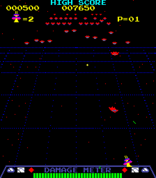Radar Scope
| Radar Scope | |
|---|---|
|
Arcade flyer of Radar Scope. | |
| Developer(s) | Nintendo R&D1 |
| Publisher(s) | Nintendo |
| Composer(s) | Hirokazu Tanaka[1] |
| Platform(s) | Arcade game |
| Release date(s) | |
| Genre(s) | Fixed shooter |
| Mode(s) | 1 to 2 players, alternating turns |
| Cabinet | Upright, cockpit, cocktail |
| CPU |
Z80 @ 3.072 MHz, i8035 @ 400 kHz |
| Sound | DAC audio |
| Display |
Raster (vertical), full-color Sanyo monitor, 224×256 resolution, 521[4] out of 768[5] colors |
Radar Scope (レーダースコープ) is an early cabinet arcade game developed and published by Nintendo in December 1979. It is a shooter that can be viewed as a cross between Taito's Space Invaders and Namco's Galaxian. It was released in three types of arcade cabinets: upright, cockpit, and cocktail. It didn't become that popular and was considered to be a commercial failure.
Contrary to popular belief, it was not Nintendo's first arcade video game. Prior Nintendo games include EVR Race (released only in Japan), Computer Othello (released only in Japan), Sheriff (released in the U.S. by Exidy as Bandido), Space Fever (released only in Japan), and Space Firebird (released by Nintendo and Gremlin Industries in the U.S.).
Radar Scope was the first game that Shigeru Miyamoto helped develop. The game's key innovation was its three-dimensional third-person perspective, which was imitated years later by shooters such as Konami's Juno First and Activision's Beamrider.[6] Although Radar Scope was only a modest success in North America, it was more successful in Japan, where it was second only to Pac-Man in popularity for some time.[7] Miyamoto's more popular Donkey Kong was based on Radar Scope's hardware, and used surplus Radar Scope cabinets.
Gameplay
As captain of the Sonic Spaceport, players must defend their station against enemy spaceships called Gamma Raiders, which attack with vengeance and swiftly retreat to formation. The object of the game is to destroy 48 enemy Gamma Raiders before the total disintegration of all of the player's Spaceports.
Players can counterattack with the Rapid-Fire Laser Blaster which zooms the lasers over the three-dimensional-esque field of curving vectors, while it intercepts enemies. The lower on the radar screen that you destroy a Gamma Raider, the more points will be earned. If exploding decoys damage the Sonic Spaceport, the Laser Blaster's firing speed will reduce. The Laser Blaster's "Damage Meter" will light up as damage is incurred and when fully illuminated, will weaken the Laser Blaster's offensive powers. To reverse this, the players must attack and destroy all remaining Gamma Raiders.
Players are given a wide range of flexibility in controlling the difficulty levels of the game. Extra Spaceports are awarded at 7,000, 10,000, 15,000 and 20,000 points, as determined by the players. The initial number of Spaceports may also be pre-programmed at 3, 4, 5 or 6. When the required number of spaceships is destroyed, players receive an extra point bonus.
Conversion to Donkey Kong
The game was popular for a short period in Japan, so the president of newly founded Nintendo of America, Minoru Arakawa, placed a large order for it. By the time the game arrived in New York, months had passed and the buzz surrounding the game had dissipated. The game's sounds were high pitched chirps which many gamers found annoying. American arcade operators were unimpressed, and Nintendo of America was stuck with thousands of unsold units sitting in the warehouse. Arakawa faced financial disaster, so he pleaded with his father-in-law (Nintendo CEO Hiroshi Yamauchi) to provide him with a new game which he could install as a replacement in the Radar Scope arcade machines, which could be repainted to reflect a new game.
Yamauchi asked all Nintendo employees to come up with ideas for a new game that could be designed with Radar Scope's hardware. Shigeru Miyamoto's idea for a game was picked, and Miyamoto worked with a small team to make the new game that would later become Donkey Kong. Conversion kits for the new game were then shipped to North America, where Arakawa, his wife and a small team did the conversions. Out of the 3000 arcade units originally manufactured, around 2000 were converted to Donkey Kong. The converted units can be spotted by their red cabinets. Donkey Kong went on to become a huge success.
References
- ↑ Hirokazu Tanaka official composition list, accessed 2011-05-05
- ↑ http://www.arcade-history.com/?n=radar-scope&page=detail&id=2155
- ↑ http://flyers.arcade-museum.com/?page=archive&db=videodb&name=radar+scope
- 1 2 http://www.progettoemma.net/gioco.php?game=radarscp
- ↑ http://mamedev.org/source/src/mame/drivers/dkong.c.html
- ↑ Where Were They Then: The First Games of Nintendo, Konami, and More (Nintendo), 1UP
- ↑ Kohler, Chris (2004). Power-Up: How Japanese Video Games Gave the World an Extra Life. Indianapolis, Ind.: Power-Up: How Japanese Video Games Gave the World an Extra Life, BradyGames. ISBN 0-7440-0424-1. Retrieved 28 February 2012.
But despite Radarscope's unoriginal gameplay ("like Galaxian from Namco but more sophisticated," recalled Arakawa), it became one of the most popular games in Tokyo. It was, at the time, the second most popular game in Japan after Pac-Man.

